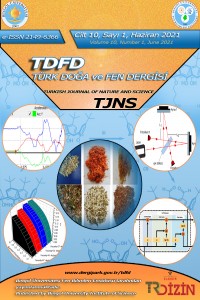Abstract
Difüzyon Yoluyla Moleküler İletişim (DYMİ) ile ilgili çalışmaların, nano teknoloji alanındaki gelişmelere büyük katkı sağladığı düşünülmektedir. Bu nedenle bu çalışmada, nano ölçekli sistemlerde potansiyel olarak kullanılabilecek yazılım tabanlı yeni bir Moleküler Haberleşme (MH) modeli geliştirilmiş ve iletişim performansı açısından analiz edilmiştir. Bu tür iletişim sistemlerinde kullanılan taşıyıcı parçacıklar hakkındaki bilgiler, DNA ve protein bileşenleri gibi biyolojik bileşenlerden oluşur. Nano ölçekli sistemlerde kullanılabilecek MH modeli, ortamın viskozitesi gibi iletişimin kanal performansı açısından analiz edilebilir. Bu çalışmada, hareketli noktasal verici ve hareketli küresel alıcı kullanılarak önerilen MC modeli için ortamın viskozitesi ve moleküllerin alıcıda alınma olasılığı analiz edilmiştir. Analiz sonucunda, alıcının molekül alma olasılığı ve alınan molekül sayısının artan viskozite ile arttığı görülmüştür.
Supporting Institution
İnönü Üniversitesi
Project Number
FDK-2019-1359
References
- [1] Tadashi N, Eckford AW. Molecular Communication. Cambridge University Press, 2013.
- [2] Akyildiz IF, Brunetti F, and Blázquez C. Nanonetworks: A new communication paradigm, Comput. Networks, vol. 52, no. 12, pp. 2260–2279, 2008.
- [3] Farsad N, Yilmaz HB, A. Eckford, Chae CB, and Guo W. A Comprehensive Survey of Recent Advancements in Molecular Communication. 2014.
- [4] Yilmaz HB, Heren AC, and Tugcu T. 3-D Channel Characteristics for Molecular Communications with an Absorbing Receiver, IEEE Commun. Lett. 3-D, pp. 1–4, 2014.
- [5] Akkaya A, Yilmaz HB, Chae CB, and Tugcu T, Effect of receptor density and size on signal reception in molecular communication via diffusion with an absorbing receiver, IEEE Commun. Lett., vol. 19, no. 2, pp. 155–158, 2015.
- [6] Er MB and Aydilek IB, Music emotion recognition by using chroma spectrogram and deep visual features, Int. J. Comput. Intell. Syst., vol. 12, no. 2, pp. 1622–1634, 2019.
- [7] Einolghozati A, Sardari M, and Fekri F. Capacity of diffusion-based molecular communication with ligand receptors, IEEE Inf. Theory Work. ITW 2011, pp. 85–89, 2011.
- [8] Singh S, Singh HR. Molecular Receptor Antennas for Nano Communication : An Overview, vol. 9028, pp. 13–16, 2016.
- [9] Felicetti L, Femminella M, and Reali G. Directional receivers for diffusion-based molecular communications, IEEE Access, vol. PP, no. c, p. 1, 2018.
- [10] Walter H, Vreebur J. Fluid Sciences and Materials Science in Space - a European Perspective, vol. 50. 1989.
- [11] Search BioNumbers - The Database of Useful Biological Numbers, 2011. [Online]. Available: https://bionumbers.hms.harvard.edu/search.aspx. [Accessed: 05-May-2015].
- [12] Schulten K, Kosztin I, and Street NM. Lectures in Theoretical Biophysics, 2000.
Abstract
Studies regarding Molecular Communication via Diffusion (MCvD) are considered to highly contribute to the developments in the field of nano-technology. Therefore, in this study, software-based a new MC model that could potentially be used in nano-scale systems was developed and analyzed in terms of communication performance. The information about the carrier particles used in such communication systems consists of biological components such as DNA and protein components. MC model that can possibly be used in nano-scale systems is analyzed in terms of channel performance of communication such as viscosity of the medium. The physical properties of the channel models such as viscosity and hitting probability of received molecules are analyzed in this study using the mobile point transmitter and spherical receiver. As a result, the probability of a molecule reception of the receiver and number of received molecules increase with increasing viscosity.
Project Number
FDK-2019-1359
References
- [1] Tadashi N, Eckford AW. Molecular Communication. Cambridge University Press, 2013.
- [2] Akyildiz IF, Brunetti F, and Blázquez C. Nanonetworks: A new communication paradigm, Comput. Networks, vol. 52, no. 12, pp. 2260–2279, 2008.
- [3] Farsad N, Yilmaz HB, A. Eckford, Chae CB, and Guo W. A Comprehensive Survey of Recent Advancements in Molecular Communication. 2014.
- [4] Yilmaz HB, Heren AC, and Tugcu T. 3-D Channel Characteristics for Molecular Communications with an Absorbing Receiver, IEEE Commun. Lett. 3-D, pp. 1–4, 2014.
- [5] Akkaya A, Yilmaz HB, Chae CB, and Tugcu T, Effect of receptor density and size on signal reception in molecular communication via diffusion with an absorbing receiver, IEEE Commun. Lett., vol. 19, no. 2, pp. 155–158, 2015.
- [6] Er MB and Aydilek IB, Music emotion recognition by using chroma spectrogram and deep visual features, Int. J. Comput. Intell. Syst., vol. 12, no. 2, pp. 1622–1634, 2019.
- [7] Einolghozati A, Sardari M, and Fekri F. Capacity of diffusion-based molecular communication with ligand receptors, IEEE Inf. Theory Work. ITW 2011, pp. 85–89, 2011.
- [8] Singh S, Singh HR. Molecular Receptor Antennas for Nano Communication : An Overview, vol. 9028, pp. 13–16, 2016.
- [9] Felicetti L, Femminella M, and Reali G. Directional receivers for diffusion-based molecular communications, IEEE Access, vol. PP, no. c, p. 1, 2018.
- [10] Walter H, Vreebur J. Fluid Sciences and Materials Science in Space - a European Perspective, vol. 50. 1989.
- [11] Search BioNumbers - The Database of Useful Biological Numbers, 2011. [Online]. Available: https://bionumbers.hms.harvard.edu/search.aspx. [Accessed: 05-May-2015].
- [12] Schulten K, Kosztin I, and Street NM. Lectures in Theoretical Biophysics, 2000.
Details
| Primary Language | English |
|---|---|
| Subjects | Engineering |
| Journal Section | Articles |
| Authors | |
| Project Number | FDK-2019-1359 |
| Publication Date | June 25, 2021 |
| Published in Issue | Year 2021 Volume: 10 Issue: 1 |
Cite
This work is licensed under the Creative Commons Attribution-Non-Commercial-Non-Derivable 4.0 International License.


